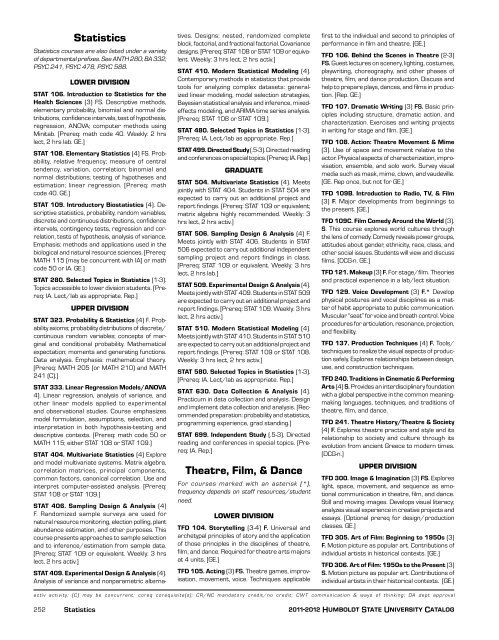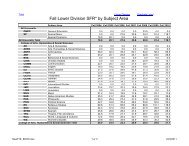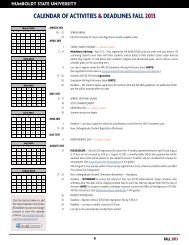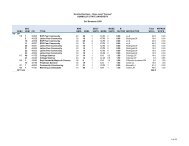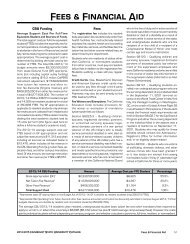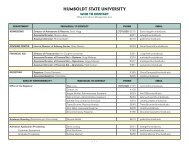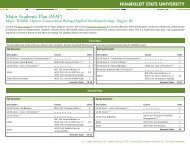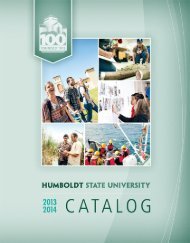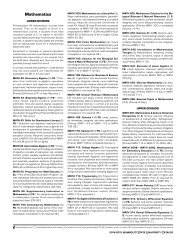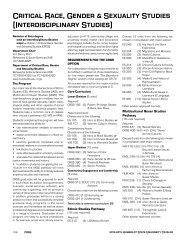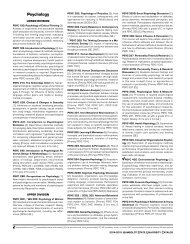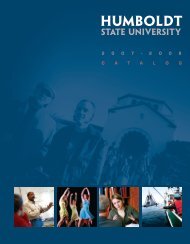2011-12 Academic Year - Bad Request - Humboldt State University
2011-12 Academic Year - Bad Request - Humboldt State University
2011-12 Academic Year - Bad Request - Humboldt State University
Create successful ePaper yourself
Turn your PDF publications into a flip-book with our unique Google optimized e-Paper software.
Statistics<br />
Statistics courses are also listed under a variety<br />
of departmental prefixes. See ANTH 280; BA 332;<br />
PSYC 241, PSYC 478, PSYC 588.<br />
LOWER DIVISION<br />
STAT 106. Introduction to Statistics for the<br />
Health Sciences (3) FS. Descriptive methods,<br />
elementary probability, binomial and normal distributions,<br />
confidence intervals, test of hypothesis,<br />
regression, ANOVA; computer methods using<br />
Minitab. [Prereq: math code 40. Weekly: 2 hrs<br />
lect, 2 hrs lab. GE.]<br />
STAT 108. Elementary Statistics (4) FS. Probability,<br />
relative frequency; measure of central<br />
tendency, variation, correlation; binomial and<br />
normal distributions; testing of hypotheses and<br />
estimation; linear regression. [Prereq: math<br />
code 40. GE.]<br />
STAT 109. Introductory Biostatistics (4). Descriptive<br />
statistics, probability, random variables,<br />
discrete and continuous distributions, confidence<br />
intervals, contingency tests, regression and correlation,<br />
tests of hypothesis, analysis of variance.<br />
Emphasis: methods and applications used in the<br />
biological and natural resource sciences. [Prereq:<br />
MATH 115 (may be concurrent with IA) or math<br />
code 50 or IA. GE.]<br />
STAT 280. Selected Topics in Statistics (1-3).<br />
Topics accessible to lower division students. [Prereq:<br />
IA. Lect/lab as appropriate. Rep.]<br />
UPPER DIVISION<br />
STAT 323. Probability & Statistics (4) F. Probability<br />
axioms; probability distributions of discrete/<br />
continuous random variables; concepts of marginal<br />
and conditional probability. Mathematical<br />
expectation; moments and generating functions.<br />
Data analysis. Emphasis: mathematical theory.<br />
[Prereq: MATH 205 (or MATH 210) and MATH<br />
241 (C).]<br />
STAT 333. Linear Regression Models/ANOVA<br />
4). Linear regression, analysis of variance, and<br />
other linear models applied to experimental<br />
and observational studies. Course emphasizes<br />
model formulation, assumptions, selection, and<br />
interpretation in both hypothesis-testing and<br />
descriptive contexts. [Prereq: math code 50 or<br />
MATH 115; either STAT 108 or STAT 109.]<br />
STAT 404. Multivariate Statistics (4) Explore<br />
and model multivariate systems. Matrix algebra,<br />
correlation matrices, principal components,<br />
common factors, canonical correlation. Use and<br />
interpret computer-assisted analysis. [Prereq:<br />
STAT 108 or STAT 109.]<br />
STAT 406. Sampling Design & Analysis (4)<br />
F. Randomized sample surveys are used for<br />
natural resource monitoring, election polling, plant<br />
abundance estimation, and other purposes. This<br />
course presents approaches to sample selection<br />
and to inference/estimation from sample data.<br />
[Prereq: STAT 109 or equiv a lent. Weekly: 3 hrs<br />
lect, 2 hrs activ.]<br />
STAT 409. Experimental Design & Analysis (4).<br />
Analysis of variance and nonparametric alterna-<br />
tives. Designs: nested, randomized complete<br />
block, factorial, and fractional factorial. Co variance<br />
designs. [Prereq: STAT 108 or STAT 109 or equivalent.<br />
Weekly: 3 hrs lect, 2 hrs activ.]<br />
STAT 410. Modern Statistical Modeling (4).<br />
Contemporary methods in statistics that provide<br />
tools for analyzing complex datasets: generalized<br />
linear modeling, model selection strategies,<br />
Bayesian statistical analysis and inference, mixedeffects<br />
modeling, and ARIMA time series analysis.<br />
[Prereq: STAT 108 or STAT 109.]<br />
STAT 480. Selected Topics in Statistics (1-3).<br />
[Prereq: IA. Lect/lab as appropriate. Rep.]<br />
STAT 499. Directed Study (.5-3). Directed reading<br />
and conferences on special topics. [Prereq: IA. Rep.]<br />
GRADUATE<br />
STAT 504. Multivariate Statistics (4). Meets<br />
jointly with STAT 404. Students in STAT 504 are<br />
expected to carry out an additional project and<br />
report findings. [Prereq: STAT 109 or equivalent;<br />
matrix algebra highly recommended. Weekly: 3<br />
hrs lect, 2 hrs activ.]<br />
STAT 506. Sampling Design & Analysis (4) F.<br />
Meets jointly with STAT 406. Students in STAT<br />
506 expected to carry out additional independent<br />
sampling project and report findings in class.<br />
[Prereq: STAT 109 or equivalent. Weekly: 3 hrs<br />
lect, 2 hrs lab.]<br />
STAT 509. Experimental Design & Analysis (4).<br />
Meets jointly with STAT 409. Students in STAT 509<br />
are expected to carry out an additional project and<br />
report findings. [Prereq: STAT 109. Weekly: 3 hrs<br />
lect, 2 hrs activ.]<br />
STAT 510. Modern Statistical Modeling (4).<br />
Meets jointly with STAT 410. Students in STAT 510<br />
are expected to carry out an additional project and<br />
report findings. [Prereq: STAT 109 or STAT 108.<br />
Weekly: 3 hrs lect, 2 hrs activ.]<br />
STAT 580. Selected Topics in Statistics (1-3).<br />
[Prereq: IA. Lect/lab as appropriate. Rep.]<br />
STAT 630. Data Col lection & Analysis (4).<br />
Practicum in data collection and analysis. Design<br />
and implement data collection and analysis. [Recommended<br />
preparation: probability and statistics,<br />
programming experience, grad standing.]<br />
STAT 699. Independent Study (.5-3). Directed<br />
reading and conferences in special topics. [Prereq:<br />
IA. Rep.]<br />
Theatre, Film, & Dance<br />
For courses marked with an asterisk (*),<br />
frequency depends on staff resources/student<br />
need.<br />
LOWER DIVISION<br />
TFD 104. Storytelling (3-4) F. Universal and<br />
archetypal principles of story and the application<br />
of those principles in the disciplines of theatre,<br />
film, and dance. Required for theatre arts majors<br />
at 4 units. [GE.]<br />
TFD 105. Acting (3) FS. Theatre games, improvisation,<br />
movement, voice. Techniques applicable<br />
first to the individual and second to principles of<br />
performance in film and theatre. [GE.]<br />
TFD 106. Behind the Scenes in Theatre (2-3)<br />
FS. Guest lectures on scenery, lighting, costumes,<br />
playwriting, choreography, and other phases of<br />
theatre, film, and dance production. Discuss and<br />
help to prepare plays, dances, and films in production.<br />
[Rep. GE.]<br />
TFD 107. Dramatic Writing (3) FS. Basic principles<br />
including structure, dramatic action, and<br />
characterization. Exercises and writing projects<br />
in writing for stage and film. [GE.]<br />
TFD 108. Action: Theatre Movement & Mime<br />
(3). Use of space and movement relative to the<br />
actor. Physical aspects of characterization, improvisation,<br />
ensemble, and solo work. Survey visual<br />
media such as mask, mime, clown, and vaudeville.<br />
[GE. Rep once, but not for GE.]<br />
TFD 109B. Intro duc tion to Radio, TV, & Film<br />
(3) F. Major developments from beginnings to<br />
the present. [GE.]<br />
TFD 109C. Film Comedy Around the World (3).<br />
S. This course explores world cultures through<br />
the lens of comedy. Comedy reveals power groups,<br />
attitudes about gender, ethnicity, race, class, and<br />
other social issues. Students will view and discuss<br />
films. [DCG-n. GE.]<br />
TFD <strong>12</strong>1. Makeup (3) F. For stage/film. The ories<br />
and practical experience in a lab/lect situation.<br />
TFD <strong>12</strong>9. Voice Development (3) F.* Develop<br />
physical postures and vocal disciplines as a matter<br />
of habit appropriate to public communication.<br />
Muscular “seat” for voice and breath control. Voice<br />
procedures for articulation, resonance, projection,<br />
and flexibility.<br />
TFD 137. Production Techniques (4) F. Tools/<br />
techniques to realize the visual aspects of production<br />
safely. Explores relationships between design,<br />
use, and construction techniques.<br />
TFD 240. Traditions in Cinematic & Performing<br />
Arts (4) S. Provides an interdisciplinary foundation<br />
with a global perspective in the common meaningmaking<br />
languages, techniques, and traditions of<br />
theatre, film, and dance.<br />
TFD 241. Theatre History/Theatre & Society<br />
(4) F. Explores theatre practice and style and its<br />
relationship to society and culture through its<br />
evolution from ancient Greece to modern times.<br />
[DCG-n.]<br />
UPPER DIVISION<br />
TFD 300. Image & Imagination (3) FS. Explores<br />
light, space, movement, and sequence as emotional<br />
communication in theatre, film, and dance.<br />
Still and moving images. Develops visual literacy;<br />
analyzes visual experience in creative projects and<br />
essays. [Optional prereq for design/production<br />
classes. GE.]<br />
TFD 305. Art of Film: Beginning to 1950s (3)<br />
F. Motion picture as popular art. Contributions of<br />
individual artists in historical contexts. [GE.]<br />
TFD 306. Art of Film: 1950s to the Present (3)<br />
S. Motion picture as popular art. Contributions of<br />
individual artists in their historical contexts. [GE.]<br />
activ activity; (C) may be concurrent; coreq corequisite(s); CR/NC mandatory credit/no credit; CWT communication & ways of thinking; DA dept approval<br />
252 Statistics<br />
<strong>2011</strong>-20<strong>12</strong> <strong>Humboldt</strong> <strong>State</strong> <strong>University</strong> Catalog


